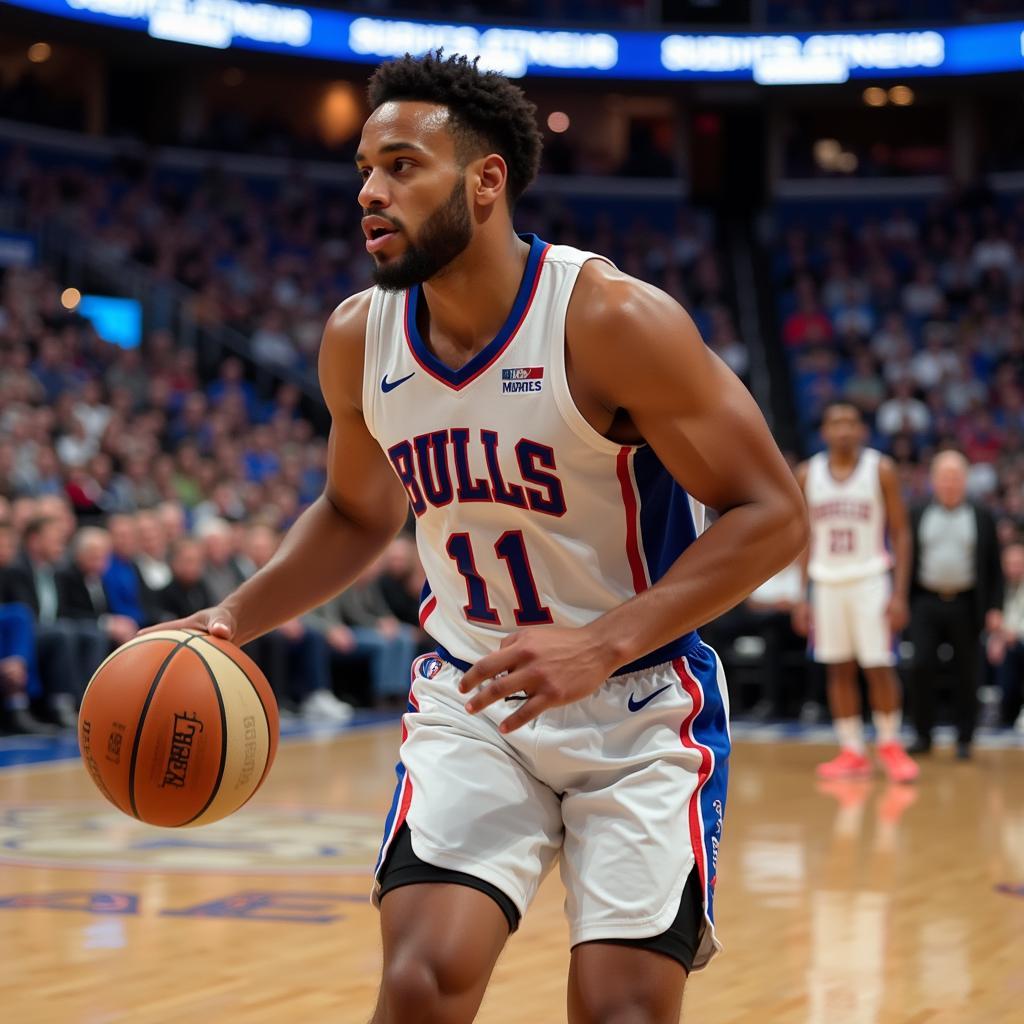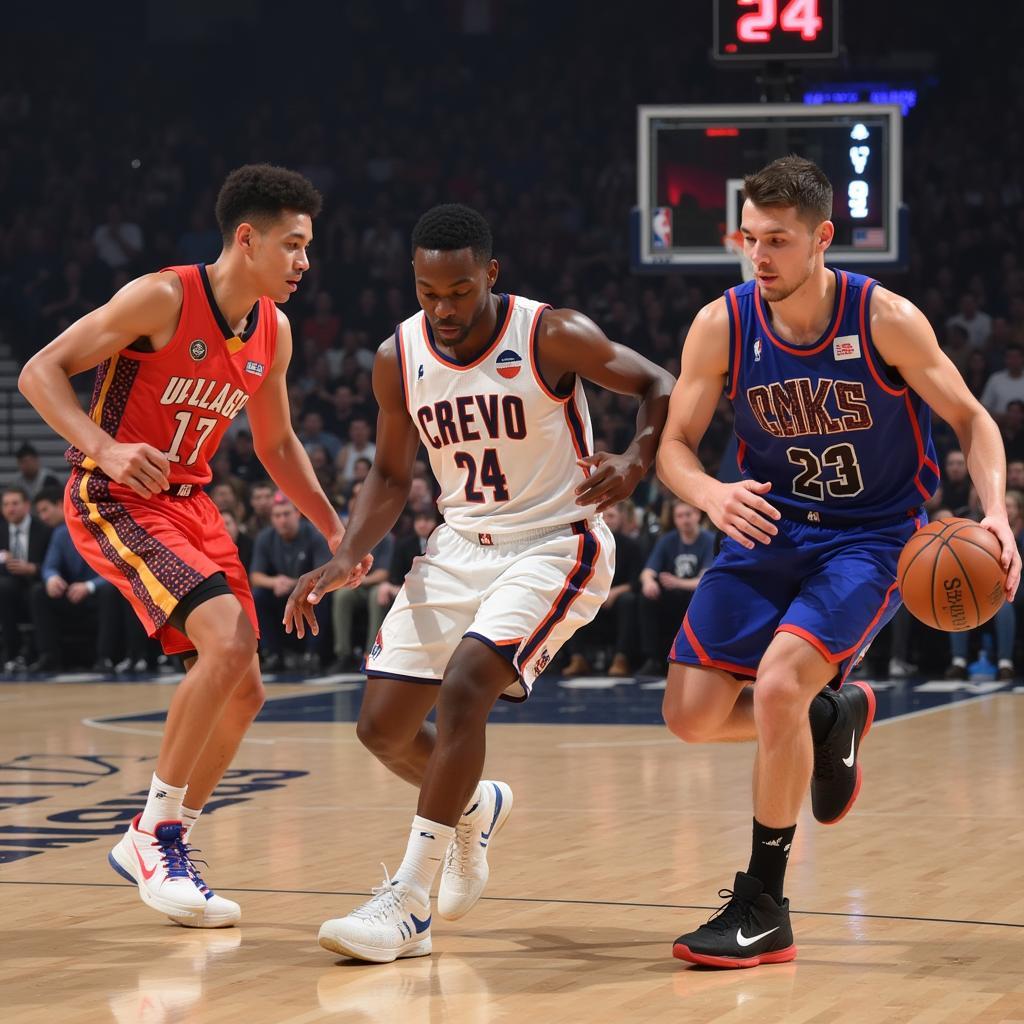Understanding Basketball Player Positions
October 17, 2024Basketball, a game of skill, strategy, and teamwork, relies heavily on the distinct roles of each player on the court. These roles, better known as “basketball player positions,” are crucial to a team’s success. Each position demands a unique set of skills, physical attributes, and tactical understanding of the game. Knowing these positions is fundamental to comprehending the dynamics and intricacies of basketball.
Traditional Basketball Positions: The Foundation of the Game
The traditional basketball lineup comprises five distinct positions, each contributing specifically to the team’s overall performance:
1. Point Guard: The Floor General
Often referred to as the “coach on the court,” the point guard is responsible for directing the offense. They possess exceptional ball-handling skills, court vision, and the ability to create scoring opportunities for themselves and their teammates.
 Point guard dribbling the ball up the court, directing the offense.
Point guard dribbling the ball up the court, directing the offense.
Key Responsibilities:
- Dribbling: The point guard is the primary ball-handler, responsible for bringing the ball up the court and initiating the offense.
- Passing: Excellent passing skills are crucial, as they distribute the ball to teammates in scoring positions.
- Court Vision: They must possess a keen understanding of the game, anticipating plays and identifying open teammates.
- Decision-Making: Point guards make split-second decisions, choosing whether to shoot, pass, or drive to the basket.
2. Shooting Guard: The Scoring Threat
As their name suggests, shooting guards are typically the team’s best perimeter shooters. They are adept at creating their own shots and are a constant threat from beyond the arc.
Key Responsibilities:
- Shooting: Shooting guards are known for their accuracy and range, often taking high-percentage shots.
- Ball-Handling: While not their primary role, they need solid ball-handling skills to create their own shots and relieve pressure from the point guard.
- Off-Ball Movement: They are constantly moving, using screens and cuts to create space for open shots.
3. Small Forward: The Versatile Wing
Small forwards are versatile players who contribute in various aspects of the game. They often possess a combination of size, athleticism, and skill, making them a threat both offensively and defensively.
 A small forward driving to the basket, guarded by an opponent.
A small forward driving to the basket, guarded by an opponent.
Key Responsibilities:
- Scoring: They can score from multiple positions on the court, both inside and outside the paint.
- Rebounding: Their size and athleticism allow them to contribute on the boards.
- Defense: They often guard the opponent’s best perimeter player, requiring versatility and defensive awareness.
4. Power Forward: The Workhorse Inside
Power forwards are strong and physical players who excel in the paint. They are responsible for rebounding, inside scoring, and battling for position under the basket.
Key Responsibilities:
- Rebounding: They are dominant rebounders, both offensively and defensively, securing possessions for their team.
- Inside Scoring: Power forwards are known for their post-up game, hook shots, and putbacks.
- Physicality: They set screens, box out opponents, and are not afraid of contact under the basket.
5. Center: The Anchor in the Paint
The center is typically the tallest player on the team, anchoring the defense and dominating the paint. They are responsible for protecting the rim, blocking shots, and securing rebounds.
Key Responsibilities:
- Rim Protection: Centers are the last line of defense, deterring opponents from driving to the basket.
- Rebounding: Their height and size give them a natural advantage in securing rebounds.
- Inside Scoring: They are a force in the paint, scoring on dunks, layups, and hook shots.
Evolving Roles: The Modern Basketball Landscape
In contemporary basketball, the lines between these traditional positions are blurring. Players are becoming more versatile, capable of handling the ball, shooting from outside, and defending multiple positions. This evolution has led to the emergence of hybrid positions:
- Point Forward: A taller player who possesses the ball-handling and playmaking abilities of a point guard.
- Stretch Four: A power forward who can consistently shoot from the perimeter, stretching the defense.
- Guard-Forward: A versatile player who can seamlessly transition between playing guard and forward positions.
 Modern basketball players showcasing their versatility on the court.
Modern basketball players showcasing their versatility on the court.
Conclusion: Understanding the Game Within the Game
Understanding basketball player positions is essential for both players and fans alike. It provides a framework for analyzing the game, recognizing strengths and weaknesses, and appreciating the unique contributions of each player on the court. As the game continues to evolve, so too will the roles and responsibilities of each position, making basketball an endlessly fascinating sport to watch and play.